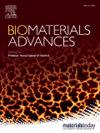Glycosylation-driven interactions of nanoparticles with the extracellular matrix: Implications for inflammation and drug delivery
IF 5.5
2区 医学
Q2 MATERIALS SCIENCE, BIOMATERIALS
Materials Science & Engineering C-Materials for Biological Applications
Pub Date : 2025-02-14
DOI:10.1016/j.bioadv.2025.214230
引用次数: 0
Abstract
Cationic nanoparticles (NPs) are emerging as promising carriers for intra-articular drug delivery, particularly for osteoarthritis (OA) where treatment options are limited. However, the clinical translation is challenged by an incomplete understanding of NP interactions within pathological environments. While the influence of the protein coronas on NP behavior has been extensively studied, the specific role of glycoproteins in the extracellular matrix (ECM) remains underexplored, representing a significant knowledge gap. This study investigates how glycosylation-driven interactions between polymeric NPs and enzyme-degraded cartilage biomolecules such as glycosaminoglycans (GAGs) affect NP-ECM aggregate formation and subsequent inflammatory responses. Using an ex vivo model of cartilage degradation induced by catabolic enzymes– hyaluronidase, ADAMTS5 and collagenase– a novel model system was developed to specifically study the behavior of small (<10 nm) and large (∼270 nm) cationic NPs in glycoprotein-enriched environments. Atomic force microscopy and dynamic light scattering revealed distinct mesh-like structures formed by the NP aggregates following different enzymatic treatments, confirming the adsorption of glycosylated fragments onto the particles. While total protein content showed minimal differences between NP samples, smaller NPs demonstrated a prominent association with GAGs such as hyaluronic acid and aggrecan, as demonstrated by circular dichroism. These ECM-NP interactions significantly influenced the immunological response, as evidenced by differential cytokine production from macrophages exposed to the aggregates. Our findings underscore the crucial, yet underappreciated, role of glycoproteins in determining NP behavior in pathological environments. Accounting for glycoprotein interactions into the design of nanomaterial and drug delivery systems could significantly improve therapeutic outcomes by enhanced targeting precision, optimized delivery, and effectively modulating immune responses in OA and other complex diseases.

求助全文
约1分钟内获得全文
求助全文
来源期刊
CiteScore
17.80
自引率
0.00%
发文量
501
审稿时长
27 days
期刊介绍:
Biomaterials Advances, previously known as Materials Science and Engineering: C-Materials for Biological Applications (P-ISSN: 0928-4931, E-ISSN: 1873-0191). Includes topics at the interface of the biomedical sciences and materials engineering. These topics include:
• Bioinspired and biomimetic materials for medical applications
• Materials of biological origin for medical applications
• Materials for "active" medical applications
• Self-assembling and self-healing materials for medical applications
• "Smart" (i.e., stimulus-response) materials for medical applications
• Ceramic, metallic, polymeric, and composite materials for medical applications
• Materials for in vivo sensing
• Materials for in vivo imaging
• Materials for delivery of pharmacologic agents and vaccines
• Novel approaches for characterizing and modeling materials for medical applications
Manuscripts on biological topics without a materials science component, or manuscripts on materials science without biological applications, will not be considered for publication in Materials Science and Engineering C. New submissions are first assessed for language, scope and originality (plagiarism check) and can be desk rejected before review if they need English language improvements, are out of scope or present excessive duplication with published sources.
Biomaterials Advances sits within Elsevier''s biomaterials science portfolio alongside Biomaterials, Materials Today Bio and Biomaterials and Biosystems. As part of the broader Materials Today family, Biomaterials Advances offers authors rigorous peer review, rapid decisions, and high visibility. We look forward to receiving your submissions!

 求助内容:
求助内容: 应助结果提醒方式:
应助结果提醒方式:


